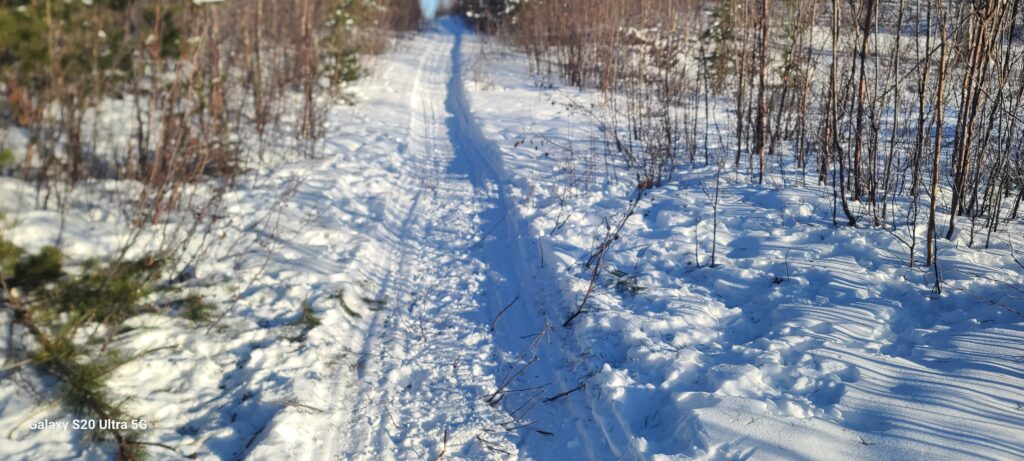
A Day of Reflection
Introduction:
In the spirit of inquiry-based learning, a subject we touched on in our last class with guest speaker Jeff Hopkins, I decided to write about one area in my life I feel enthusiastic about, which many may have strong feelings about and misunderstand. I aim to write a running commentary on a typical day out on the trap line. Like many things that people do not understand or fear, the ancient tradition of trapping has come under fire from many people, such as wildlife activists. People pass judgment on the practice of trapping without knowing all the details about this ancient pastime. The activists’ actions are based on emotion and misinformation, information taken out of context or cherry-picked information. Trapping is not just a legal means to kill living animals just for the sake of killing; on the contrary, trappers as a group care very deeply about the environment and the wildlife contained therein. It is my hope that if you are reading this, you do so with an open mind and truly learn what it means to be a trapper without including any preconceived biases on the subject. Throughout this blog, I will describe many attitudes, skills, and practices needed to participate in this tradition, such as how to become a trapper, where you can trap, purchasing a trap line, what a day in the woods looks like, dispelling propaganda, why hunting and trapping is better than going to the grocery store, being observant, safety, preparedness, looking at tracks, modified vegetation, trap set up and baiting, thoughts on different forest types and their influence on wildlife, a battle of wits, what do trappers see out in the bush, what do I hear out there, tools of the trade, maintenance, and why is nature so important to me.
For over a decade, my colleague, mentor, and friend invited me to travel his trap line with him. Initially, as an avid outdoorsman who loves hiking, skiing, and various other outdoor activities, I took him up on his offer and have continued to travel the trap line with him to this day. I am so grateful that I decided to accompany my mentor on his trap line, as I have learned so much more about the outdoors and what lives there than I ever could have in any other way.
Observation:
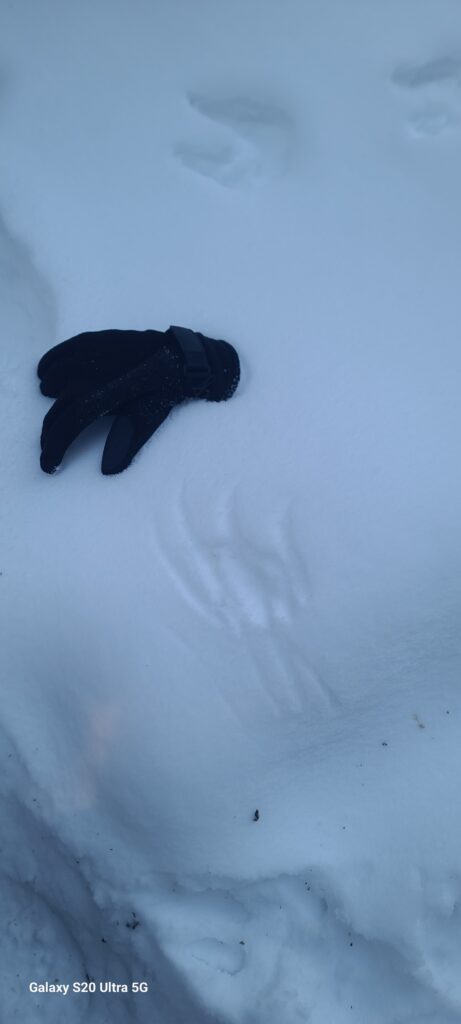
One of the most profound realizations I’ve had while working on the trapline is that people are far less observant than we often believe ourselves to be. Developing true awareness in the wilderness is not simply a matter of looking around and assuming you’ve seen everything. In reality, unless you have specialized training, your perception barely scratches the surface of what is actually going on in the forest. The natural world is far more complex and dynamic than we typically recognize. Emerging research on the mycelium network alone demonstrates just how much is happening beneath our feet, beyond our immediate perception. Countless aspects of wildlife and ecosystems remain unknown to us, particularly regarding the specific environmental conditions different species require to thrive. Despite spending a lifetime in nature, constantly observing and striving to understand, I have realized how little I truly know. However, the more one pays attention, the more the forest reveals its hidden intricacies, offering endless opportunities for discovery. I will continue to learn until I can no longer.
Going back in Time:
Backing up in time a little bit I would like to talk about a time in my childhood where I spent lots of time out in the environment. My grandfather had a 110-acre farm along the Endako River Valley that I explored and spent time riding dirt bikes, fishing, and exploring the crown land just across the highway. I spent a lot of time here; the farm was an amazing place to grow up. My grandparents’ farm was 20 minutes from the nearest town by highway. That town was rather small and didn’t have much infrastructure. Often, to get supplies, groceries, and gas, the 35-minute drive was made to Burns Lake. This trip obviously did not happen daily, so my grandparents did their best to be as self-sufficient as possible. They had two large gardens consisting of about an acre and a half of land. They grew enough carrots, potatoes, peas, beans, currents, strawberries, and many other fruits and vegetables to last throughout the year. My grandparents raised a variety of livestock as well, including cows, pigs, chickens, geese, sheep, and horses, and sometimes they threw in a donkey for good measure. Growing up here, I often participated in hauling wood for the household, harvesting the garden, and butchering animals for food. My family also hunted. I got used to the sight of blood and knew where my food came from. As a young child, it was not always easy to dispatch an animal (or watch), but I learned that it is a necessary part of being human. To survive, we need to eat things. Therefore, things must perish for us to survive. I also understood that our farm animals’ lives were far better than livestock from large factory farms. These days, I long to have the amount of preparedness my ancestors had in my life. I have always liked to know where my food comes from and have a food supply for the winter.
The farm bordered the Savory Ridge, which provided thousands of acres of bush for a young boy to explore. Most of the time, I explored it on my own. I would often ride my dirt bike or snowmobile out along trails and old mining right away to see what I could find out there; the time alone made for some great reflection time. I discovered new trails and lakes and a myriad of wildlife and their tracks. Back then, I could only differentiate between a few tracks, such as moose and deer, bear, grouse, rabbit, and squirrel. I saw many different tracks and saw much wildlife, but the tracks did not speak to me like they do today.
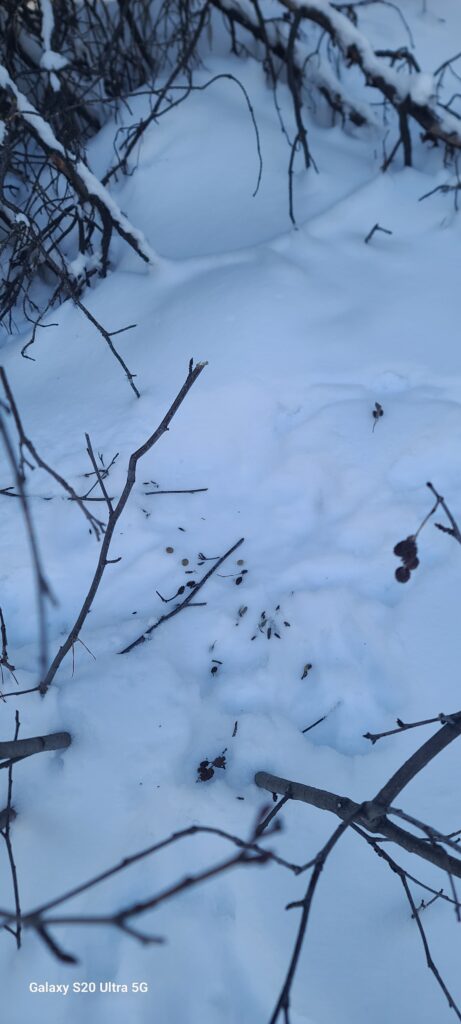
It wasn’t until much later that I learned about more various species of tracks. Once you learn to read the tracks, they tell quite a detailed story, not unlike the words in a book. They can tell you who the main character is, what they were doing, why they were doing it, and sometimes who the protagonist and antagonist are in the little story, although those change depending on your point of view.
My first exposure to trapping and hunting came at a young age. My grandfather was a trapper, and sometimes, so were my uncles when they lived at home. It was commonplace to see beaver skins stretched out on plywood and various other species. I participated a bit in trapping with my grandfather accompanying me, but I was quite young and didn’t learn much before he quit trapping. Recently, I obtained my trapping license to honour my grandfather and help my friend and mentor on his trap line. One is not legally allowed to check someone else’s traps unaccompanied.
How does one become a trapper, you may ask? The process could be a little different depending on the person. One could begin to learn trapping from one’s family or a friend, like myself, but if you wish to trap, you must take the course and obtain your license. In my early thirties and forties, I spent a decade following, watching, and learning from my friend and seasoned trapper, and I still feel I know very little about trapping. The amount of information to know is staggering; it will take a lifetime to learn.
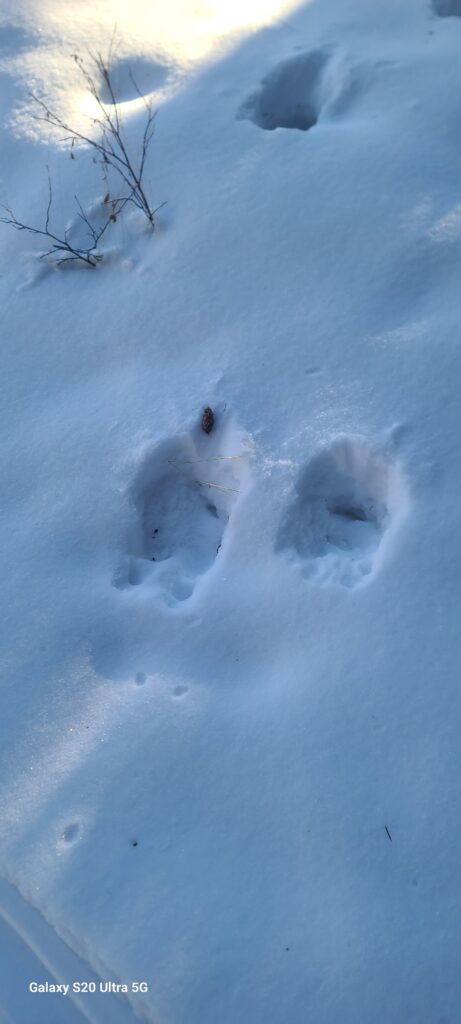
How to become a Trapper:
To become a certified trapper in British Columbia, one must complete a comprehensive training course administered by the British Columbia Trapper’s Association (BCTA). This course is offered annually in various locations across the province. The program provides an in-depth understanding of legal trapping practices in BC while emphasizing the importance of environmental stewardship. It covers humane trapping methods, the historical and scientific foundations of ethical trapping, and the proper use and maintenance of trapping equipment. Also, participants learn practices for pelt preparation, such as stretching and scraping, principles of wildlife management specific to two fur-bearing species, and the fundamentals of running a small trapping business. Most importantly, the course prioritizes safety as its most critical component.
Where can you trap:
Once a person obtains their trapping license, they have two options for where to trap. They may trap on private land, provided they have written permission from the landowner, or they can operate within an established trap line. To trap on a trap line, an individual must purchase one outright or secure written authorization from the holder. This written permission must then be submitted to the government.
The entire province of British Columbia has been divided into designated trap lines. This means that the government does not issue new ones. Every piece of land in the province falls within an existing trap line, so aspiring trappers must find someone willing to sell theirs or get permission to trap on someone else’s line. In some cases, the nearest available trap line to purchase may be located far from where the trapper lives, making regular visits and upkeep challenging. My friend and mentor, however, is truly fortunate; his trap line is located right outside his front door, which also happens to be near my home as well. (other side of the lake) Because of this, he can set and check his traps throughout the season without needing to take time off work or factor in extensive travel time.
Transportation:
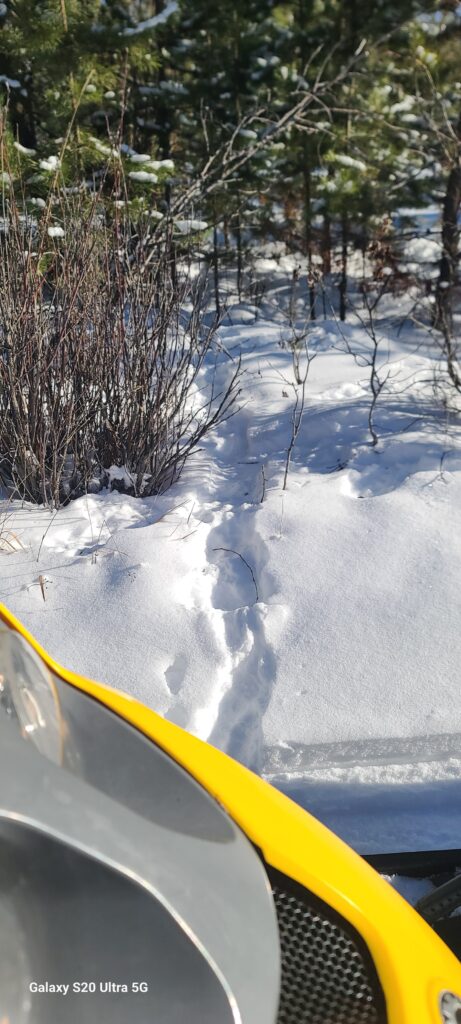
The method of travel depends on the season. A snowmobile is essential mid-winter, while a quad may be preferable in the early winter and summer. Not much trapping occurs in the winter, but it is important to keep the trail clear. The beetle-kill trees have made the last 20 years of trapping labour-intensive due to clearing the number of fallen trees across the trail. Snowshoes or skis might also work if the trap line is relatively short. Typically, a skimmer (a sled used for hauling gear) is pulled behind the snowmobile, and a toolbox is mounted on the back of the snow machine. These are used for carrying bait and necessary tools and supplies.
Traps:
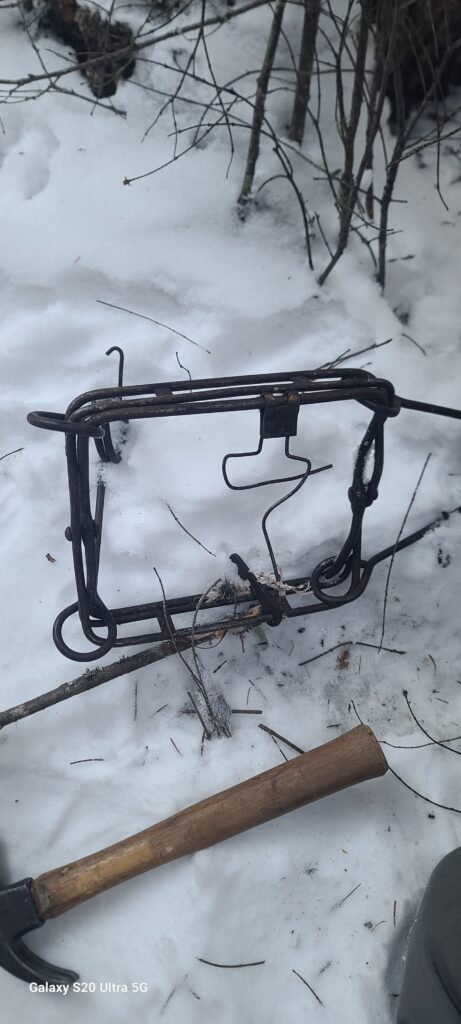
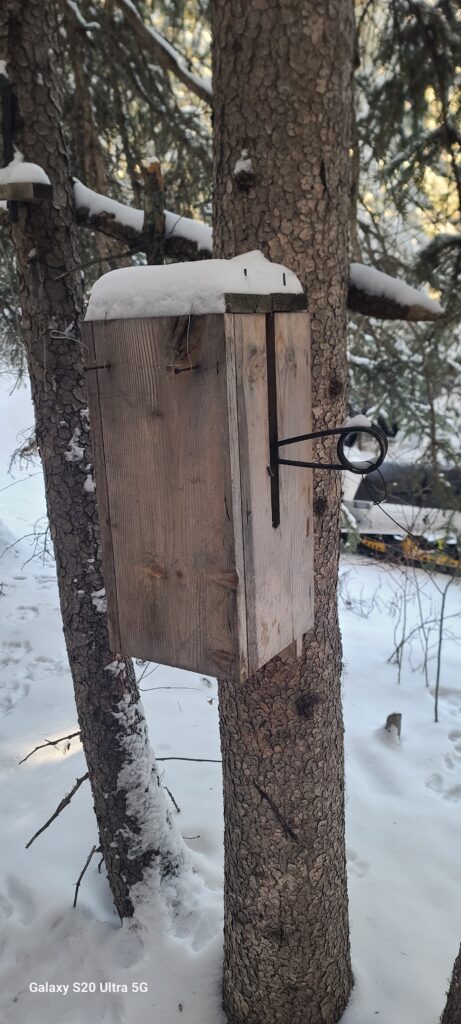
The type and size of the trap deployed depend on the target species. Traps of various sizes, trap boxes, and snares are all packed on the snowmobile. Different traps and snares are specialized for catching different animals.
Tools, Supplies, and Safety Equipment
A well-equipped trapper will carry a range of essential tools, including a trap safety tool, a trap setter, an axe, a chainsaw, a hand saw, pliers, a screwdriver, and screws. Additional safety gear is also crucial to ensure preparedness for any situation.
Bait and Scents:
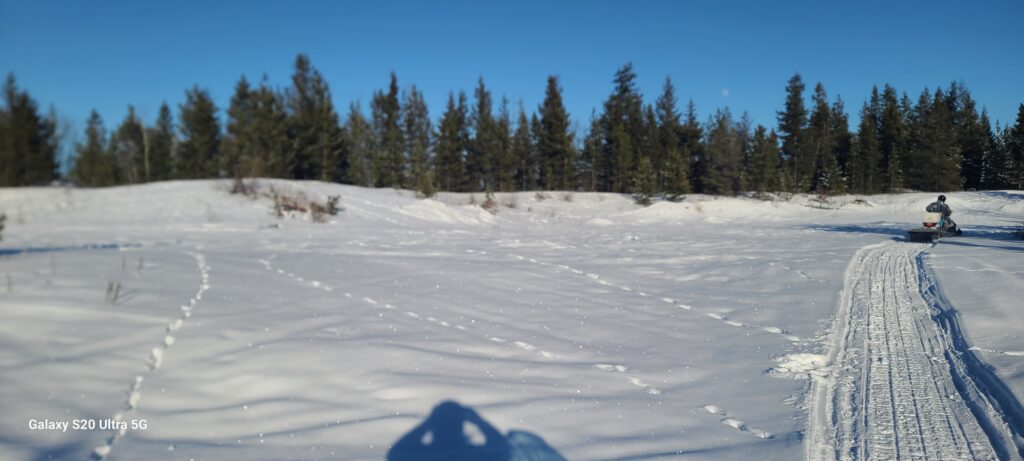
Although any type of wild game meat can be used as bait, animals like humans have preferences. Carnivorous species tend to favour beaver meat due to its high-fat content and strong scent, making it easier to detect. High-calorie food sources are the most effective, as wild animals instinctively seek out the most energy-dense options, and beaver meat is high in fat. More than bait, trappers also use specialized scents to attract specific species. For example, beaver scent is derived from beaver castor and glandular oil, while lynx scent may contain catnip or fish sauce. Canines like wolves and coyotes are typically drawn to urine-based scents.
Personal Equipment:
The duration of a trap line trip can vary significantly, from just a few hours to several months, depending on the trap lines’ location and the trapper’s schedule. In our case, we typically spend several hours on the trap line.
Spending extended time outdoors in the winter demands proper winter clothing. Warm, layered clothing is essential to maintain body heat while preventing excessive sweating. Wool and polyester are preferred over cotton, as cotton retains moisture and offers little insulation. Winter boots, snow pants, a balaclava, a helmet, and winter gloves are also must-haves.
A night in the bush:
You should always be prepared to spend the night in the bush if your machine breaks down. Food, water, and an ignition source to start a fire should also be considered requirements to go out into the bush. Depending on the trap line and how well-defined the trail is, it would be wise to have a GPS with you to track your path. Also, everyone venturing into the bush must have an analog means of navigating through the bush, which means a map and compass. You must also have orienteering skills, so you know how to use that map encompass. Practicing beforehand is very important.
A Day on the Trapline:
Once all the supplies are loaded into the snowmobile and skimmer, we leave right from the driveway via snowmobile or quad (depending on the season).
Consideration of others:
To get to my friend’s trapline, private property has to be crossed, so we must establish permission to cross the property. The trapper must cross the property in a responsible and considerate way. If the property owner wants the snowmobile only on one section of land, you must obviously abide by his wishes. Being considerate means watching for livestock and pets, travelling at a slow pace, and not making unnecessary and excessive noise. It also means opening and closing gates behind you if that is what is expected.
Once on the trap line, the traps are not all beside each other but strung along the entire line length. The distance between traps will vary between trap lines, just like the length of the trap line will also vary. This trapline is approximately 22 km long, but there are other trails on this trapline as well.
Safety Considerations:
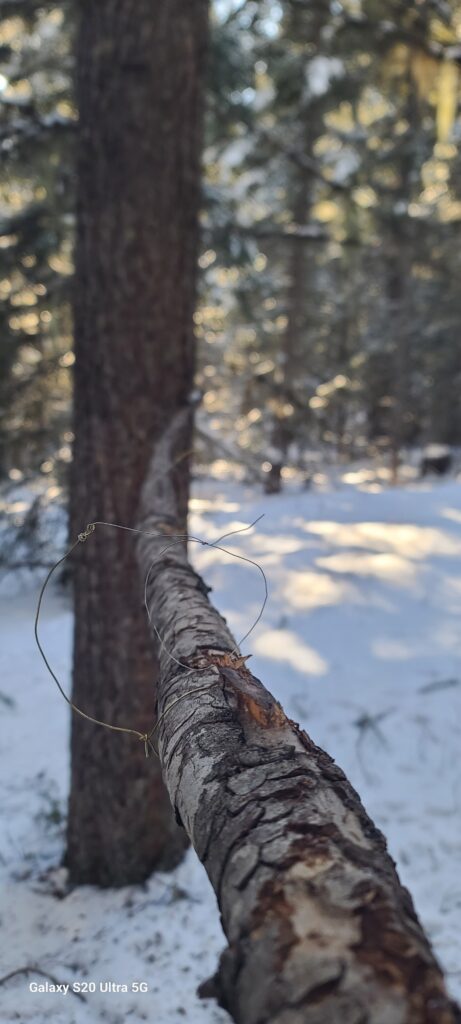
While travelling the trap line, you must watch out for various things: branches and twigs can slap you and potentially spear you if they are angled the right way. Often, these are cleared a little each time one travels the line. Also, one must be looking for trees that must be cut off the trail. Some spots must be navigated cautiously, especially if it is on a hill, and a trapper is always on the lookout for tracks. If there are many tracks of a desired species, throwing out bait or setting a trap is considered. One of the first trap sets on our line is a squirrel pole. Squirrel poles are set up where there is a large amount of debris from squirrels eating seeds from conifer trees. It really is amazing how large the squirrel” midden” can get. A pole is nailed to one tree and is set on another nail that is nailed to another tree a branch can also be used). The pole is free to move on one side so that if a wind blows up, the moving tree will not pull the nail out of the tree over time. Squirrels love to run across squirrel poles, usually set at about five feet off the ground. Each pole is about 15 feet long and has approximately 5 to 6 snares attached. The snares are wired to the pole, and a loop is set approximately one inch above the pole at about 1.5 inches in diameter. The idea is that a squirrel runs through the snare, which tightens up on his neck, causing them to fall off the pole, where they die quickly by strangulation. This sounds rather brutal; however, of the four ways to die in the bush, dying in a trap is, in fact, the quickest, most gentle way to die. This will be explained later.
Cycle of wildlife numbers:
This year, there are a great many squirrels in the forest. One thing that’s interesting about wildlife in the forest is that the amount of wildlife goes in cycles. Some years, you will have many rabbits, for example, but not many predators. This can go on for a couple of years until a large number of predators have successfully reproduced and are now feeding on the rabbits. Then, the rabbit population will be greatly reduced due to excessive predators, leaving them with little food, starving to death, and decreasing in number.
Usually, squirrel poles and traps for other species are set close together so as to save time travelling between trap sets. A weasel trap, a martin trap, and sometimes a lynx set are all set next to each other. A weasel trap is essentially a large rat trap with a cover over it (we use yogurt containers, which are free and upcycled) to allow entrance to the trap only from one side. These traps can come in various configurations but are always kill traps. The trap is baited with a small thumb-nail-sized piece of beaver meat or liver. This trap will kill a weasel instantly. A Martin trap is a conibear-type trap that is often set in a wooden box. It has rotating jaws that snap shut with a heavy spring that instantly kills the animal. It is particularly important not to get your body parts stuck in this trap (more on this later).
Why is hunting and trapping better than going to the grocery store:
I have conversed with quite a few people over the years who didn’t grow up the way that I did. Some of these people found the idea of killing and butchering an animal very off-putting. Some people even thought that killing an animal, hunting, and trapping was a very unsavoury pastime, but I think it’s pretty important to know where food comes from and how it ends up on your plate. As a society, we have lost that knowledge. It’s important to have this knowledge even if you do not wish to practice these pastimes because it helps teach respect for the animal. If you have hunted, killed, butchered, and cut an animal into steaks, the chances are you’re going to have a higher respect for that animal than if you just picked it up in some plastic wrap at the grocery store. Speaking of meat from the grocery store, the animals who were born and raised in big corporate farms have a very horrible existence up until the point that they are harvested for food. Wild game, and livestock on the other hand, lead a better where they are free to move about. Some people will argue that trapping is barbaric and that parts of the animal are wasted. In my experience, most, if not all, of the carcasses has been used as bait, often the game can also be eaten. Wildlife activists consider fur harvesting cruel as barbaric, however, I think the production and use of plastics is more murder then fur. We are poisoning the environment and our bodies with microplastics.
Have a look at the video below about factory farming and how animals are treated in these big businesses.
The Meatrix video, domestic animal living conditions
Laws Surrounding Trapping and Misinformation:
By law, traps must be checked at least every two to three days or every 72 hours. If traps are set near urban areas, they should be checked every 12 hours. Our practice has been to check the traps at least every two days. Since most animals are nocturnal, checking traps in the morning is wise to minimize the time they’re caught.
During my time out on the trap line, I have learned that there is a lot of misinformation about trapping, largely due to animal rights activist groups disseminating inaccurate information. One such example of this is on the topic of leg hold traps. Today’s modern leg-hold traps do not hurt an animal but only hold them in place. In fact, I have seen someone put their hand in a leghold trap and be uninjured. The new traps have soft jaws and do not close completely, yet when you see a leg hold trap on an activist website, it shows an old type of trap that has long since been discontinued. The picture below shows one such trap.
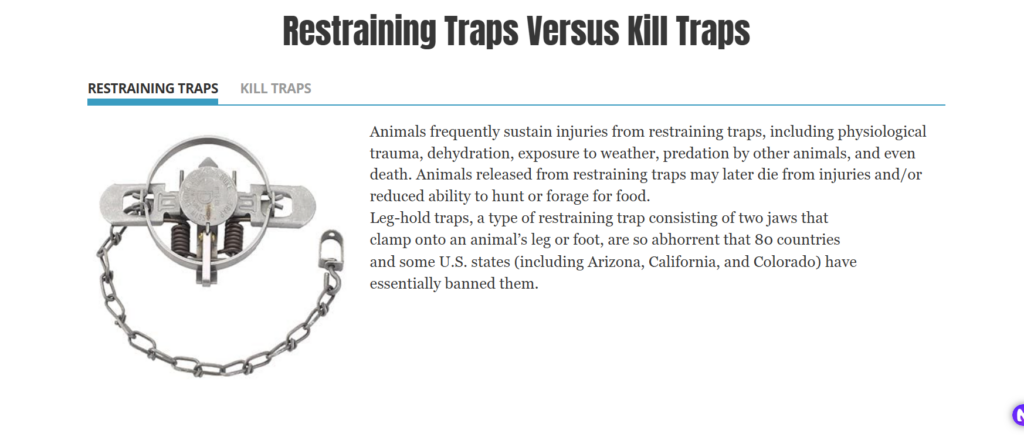
Types of Traps | Learn the Types of Animal Traps | WildEarth Guardians
Looking at the text in this picture taken from an animal rights activist website, one can see that animals are anthropomorphized when discussing psychological trauma. The article discusses exposure to the weather, but considering animals live in the forest with fur coats, this statement does not make sense to me. As I said earlier, traps are checked often, so dehydration is not an issue. Predation by other animals can definitely be an issue, but that’s why traps are often checked. Predation is also a natural process and one of the ways wildlife perishes. If the trap has been set correctly and in a proper location, virtually all of the animals that are caught in a trap are ones that the trapper is going to keep, so animals are not typically released. I did a quick search about different states banning trapping, as this picture above discusses, and it turns out Colorado still has a trapping season. So, the website, in this particular case, is wrong. I would like to caution the general public to ensure that facts back up any claims that wildlife animal rights activists make.
Here are some regulations for Colorado Trappers. Ch03.pdf
The best death:
Yes, trapping does take the lives of animals, but the lives of animals will end in one of four ways. One, the animals will starve to death; two, animals will die of disease; three, animals can wind up as prey for other animals; and four, animals can get caught and die instantly in a trap. Of the four ways to die, perishing instantly in a trap is really the most humane. Nature is cruel; can you imagine starving to death, dying slowly from a disease without help, or being eaten to death? Dying instantly sounds a whole lot more inviting than those three to me.
Here is a longer video that discusses this, among other things.
What to watch out for:
In terms of safety, a person needs to watch out for a myriad of things. Some of these things are minor, and others can be serious. Some animals, such as squirrels and weasels, carry fleas, so you must handle them carefully. Each animal, including humans, has their own species of fleas; they do not typically transfer over from one animal to another. I found this quite fascinating as I didn’t know there were different types of fleas in the world. Fleas from a squirrel or weasel will transfer onto a human, and they can be a nuisance for a couple of days, but eventually, they will leave because they don’t like a different environment.
One also must take into consideration how dangerous some traps are. Conibear traps, for example, have strong springs that are designed to kill prey instantly. If you get a hand caught in a conibear trap, you only have one hand left to free yourself. Without a trap setter, this is virtually impossible. All trappers should use trap safeties and safety hooks and respect the trap. I heard a story of a trapper who got both hands caught in a large trap and had to walk back to their vehicle where they had a file, to file through one of the springs, holding the file with their feet.
When travelling out on the trap line, temperature should be considered. It’s important to have layered clothing, and the trapper should be prepared to spend the night in the bush if something goes wrong. This means warm clothing in layers and eliminating cotton clothing, as it soaks up moisture and does not keep a person warm. A means of starting a fire (I like to carry 3) is extremely important to have, as well as water and snacks. Trapping season is typically done in the winter.
Maintenance:
It is important to maintain your machine, be it a snowmobile or a quad. When possible and in order to be safer, it’s smart to have an extra person to travel a trap line with; however, most trappers go alone most of the time.
Tracks:
The tracks are so interesting. Over a series of years, I have learned how to identify the tracks of many different animals. I have learned that the weasel family has five toes, whereas the dog family only shows four toes; the dew claw is farther up on the leg and thus does not show in the snow. I learned that the weasel families’ front feet typically come down one slightly in front of the other when they travel, and I learned that in rabbit tracks, the back feet are typically put down in front of the front feet. I also learned that coyote tracks have a distinct X between the pads and that lynx have a rounded arc placement for the front pads and are fuzzy around the edges, showing no claws.
The story:
Identifying tracks of different animals is interesting, but what’s really fascinating is what story the tracks tell. Tracks can tell you all sorts of different things that the average person would not see. For example, looking at the tracks, one can notice the difference between a male coyote and a female coyote. If you see a place where this coyote is urinating, you can determine if it is female or male just by the angle of the stream entering the snow. You can determine different sorts of behaviour from different animals as well. Lynx, for example, like to travel in a straight line, but they zigzag from one side of the trail to another. The dog family trots all over the place, sniffing here and sniffing there, and they don’t travel in a straight line. The lynx is rubbing its whiskers against branches on both sides of the trail. It will do this for a couple of reasons: one, to mark its territory; essentially, the lynx is saying hey, this is my area, back off, or for communication for mating… “calling all lady cats.” The dog family wanders all over, lead by its nose, learning who was there before them and if friends or foes exist in the area. I just learned recently that in extremely cold weather (-35 to -40), voles (small rodents) can often be seen dead on the snowmobile trail. This is because they live under the snow, where the temperature is just below freezing, and so they run across the top of the snowmobile track. It is too hard to pass under the track as the snow is packed. They freeze to death in the short time it takes to cross the path. This is a reminder that everything we do in the forest impacts it. Nothing goes to waste in the forest, though; many birds travel the trapline tails and will feed on the voles, aiding their survival. These are just a couple of things you can learn from tracks.
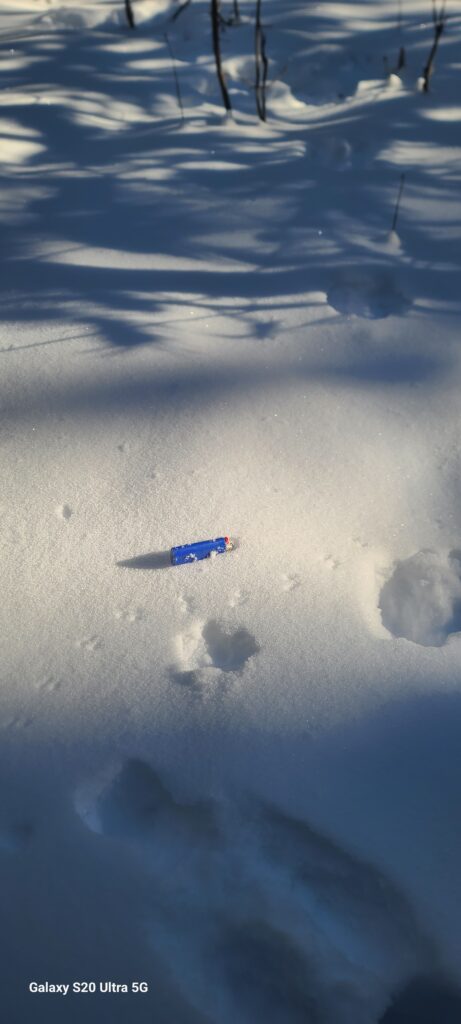
The definition of civilization:
As my friend and I travel down the trap line, we often chat and joke every time we stop. We discussed many different things; one particular thing we discussed was the definition of civilization. The general consensus in the scientific community is that agriculture is the first sign of a civilization. However, this argument is flawed if you consider hunter-gatherer tribes such as the Indigenous peoples of North America. Many did not have agriculture but lived a nomadic lifestyle instead. We often joke about moose that push over small saplings and chew the tops off. When moose do this, it makes the trees sprout more branches and become bushier, making more food for the ungulates for next winter. One could argue that this is agriculture. Is this evidence that moose have a civilization and the Aboriginals do not? I think not.
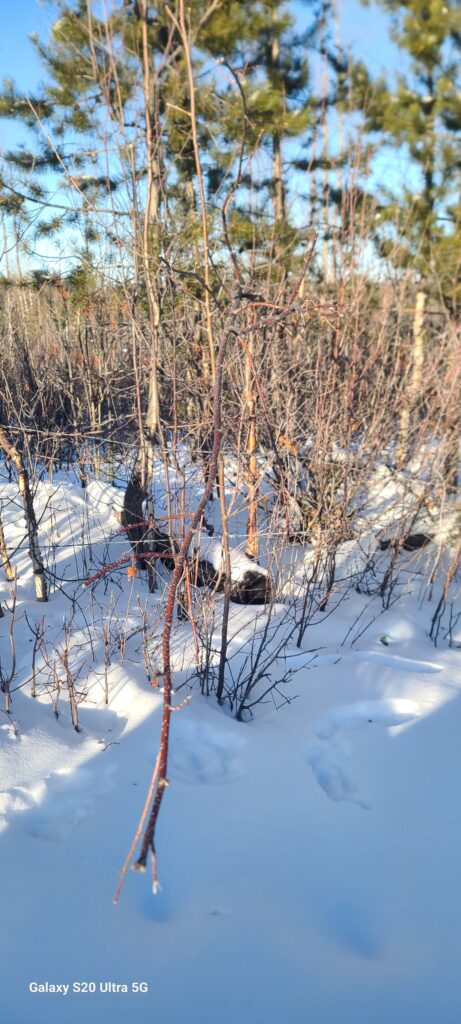
The Annual Trap Boil:
Before traps can be used, they need to be protected against the elements. They are boiled in a mixture of water and tannic acid, which cleans the traps and removes any corrosion that may have occurred over the last season. Once this process is done, the traps will be dipped in wax. In my area, this is often done as a group. Many area trappers gather, have a potluck supper, and boil traps. This is a suitable time to swap stories and disseminate expertise that may have been learned throughout the previous year. Trappers never stop learning; there is always something to learn out in the bush if you take the time to pay attention and listen.
A Battle of Wits:
Setting up a trap you would like an animal to enter is often a frustrating battle of wits. What is the animal thinking, how can I get it to step in a certain place, how can I have it not steal bait from a different angle. How can I stop other animals from getting caught or stealing bait? These are all thoughts trappers wrestle with. Animals often do not like walking where it’s more difficult, just like humans. If there is a rough area with sticks, brush, and logs in the way, animals will likely not travel through there. If there is a bunch of rough ground and there is one smooth spot to step on, chances are the animal will step in that smooth spot. That might be a good place to set a trap. If there is a nice flat area to step into to access bait, then that’s likely how the animal would travel. All this gets taken into consideration when setting up a trap to try and catch the game. Typically, the bait is made up of previously caught animals such as beaver. Beaver is a much-coveted delicacy for animals as it is high in fat; fat means calories, which means survival. Once skinned, beaver carcasses are kept and used as bait, very little if anything, goes to waste. The bait is spread out along the trapline at the beginning of the trapping season to help feed the animals to help them survive and be healthy. Doing this gets them used to the area where they find food. That is where you would set a trap.
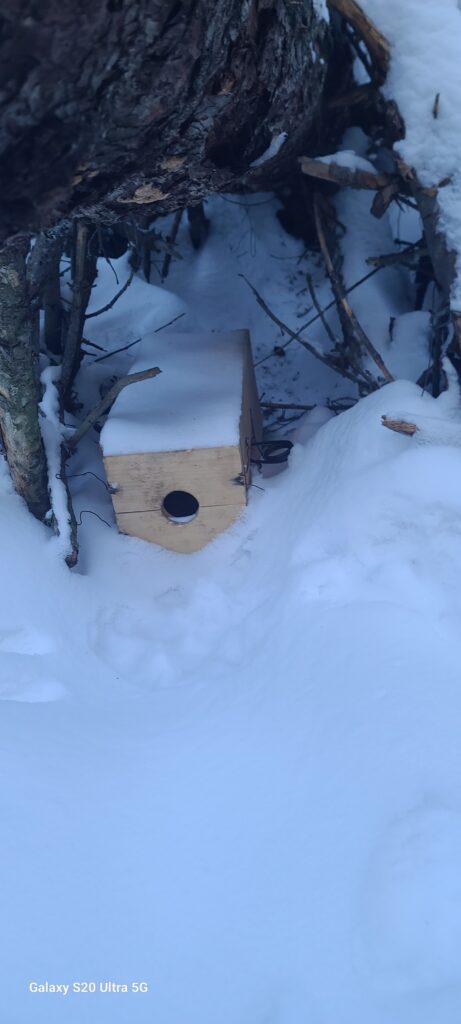
Threats to Wildlife Habitat:
Sometimes, wildlife biologists contact trappers and ask them to travel traplines to set up game cameras to see different animals’ denning habits. For example, some biologists from California have come out on the trap line with us and wanted to find a Fisher den. The biologists were doing research on how important old-growth hollow trees are for their habitat. If Fisher do not have access to old-growth forests, they will not have young; the male may breed the females but will not produce young, reducing their population. It has not been trappers that have impacted Fisher populations but rather habitat loss due to logging. Trappers install game cameras to see what is happening along the trapline and try to learn more about the wildlife in the area. There is so much going on out in the bush that we don’t see. As you travel through the bush, the animals step off the trail or hide behind the tree. They then come back out to sniff your tracks and to see what is going on, and the humans passing through the forest have no idea that a huge variety of animals are watching them.
Forestry practices are among the most significant threats to animal populations here in British Columbia. The practice of planting a mass monoculture pine plantation to take the place of the original forest is absolute insanity for a number of reasons. Once the old-growth trees are logged, the entire block is sprayed with glyphosate. This contaminates the entire area and kills off or severely stunts all the deciduous growth on that block. Glyphosate stunts plant growth by hindering its ability to absorb nutrients from the soil. The ungulate population then travels through the block (the Prince George and Vanderhoof forest district is essentially one big block now due to so much logging) and feeds on the stunted deciduous plants that are left, of which there are not many; they are essentially starving to death due to the fact that the plants don’t have any nutrients left in them. Another thing to be concerned about is that there are often blueberries and other edible plants that the local community goes out and picks on these sprayed blocks. All these will have traces of glyphosate within them. Glyphosate is used in our agriculture as well. Many grain fields in our area, across Canada and the United States, also have grain crops sprayed with glyphosate to desiccate the grain. What this means is to make the crop ripen all at the same time. What’s the problem with spraying, you may ask? Glyphosate has been tested and has been considered safe for human consumption after all. However, the company doing the study was found to be grossly negligent and was banned from performing more studies because it was not doing them properly. Many different chemicals from that time are grandfathered in as safe for human consumption, but we don’t know if they are safe. In the case of Glyphosate, Monsanto has had numerous court cases against them due to people contracting cancer, related to exposure to Glyphosate. I watched a documentary called Into the Weeds about a gentleman who worked for a school district in the States. His job was to spray Glyphosate on invasive weeds within the school district. He was spraying something called Ranger, which is a concentrated form of the Glyphosate spray. One day, he had a chemical spill and had Glyphosate chemical all over his body. This gentleman, years later, now has severe skin cancer, among other things. He sued Monsanto. Not only are we killing our ungulates, but we are also contaminating ourselves with glyphosate spraying.
Once a sprayed pine plantation is established, nothing grows beneath its canopy. The trees are thick, and not much sun reaches the ground. All the deciduous trees that were sprayed are long dead.
Fire Hazard:
The conifer plantations are also extremely flammable, leading to many forest fire issues within BC. Deciduous trees, however, are quite resistant to forest fires, which is quite interesting. The issue is companies don’t think that deciduous trees are worth anything. In a capitalist society, money is important, and money for shareholders is the most important thing. People’s health and a healthy ecosystem are often just collateral damage. A healthy forest for wildlife is a mixed forest. A mix of deciduous and conifers of various ages is ideal. I, for one, am not against sustainable logging practices, but if you were to look in central BC, you would find most of the forests here are logged flat, which is not very sustainable. Many of the immature pine plantations here have burned because that is all that’s been planted since the 1970s.
Conclusion:
Why Trapping is so Important to me
While reflecting on why trapping is so important, I can consider a few reasons. I think the most important reason is that I like to be self-sufficient. It’s not just the trapping itself but the skills involved in trapping. I like the challenge of trying to outwit an intelligent animal who is 100% at home in the wild as opposed to humans. I like to be able to operate and maintain machinery, as a shop teacher it has always been important for me to know how to fix things and to know how things work. I have always prided myself on easily navigating the bush without getting lost, so practicing those skills is also important to me. Learning is a lifelong process, and I find the behaviours of wild animals and the things that go on in the bush fascinating. There is always more to learn. Finally, being out in nature is extremely healthy and helps me to destress. I feel more at home in the forest than in a city.
I hope you learned something from this blog and that you could keep an open mind.
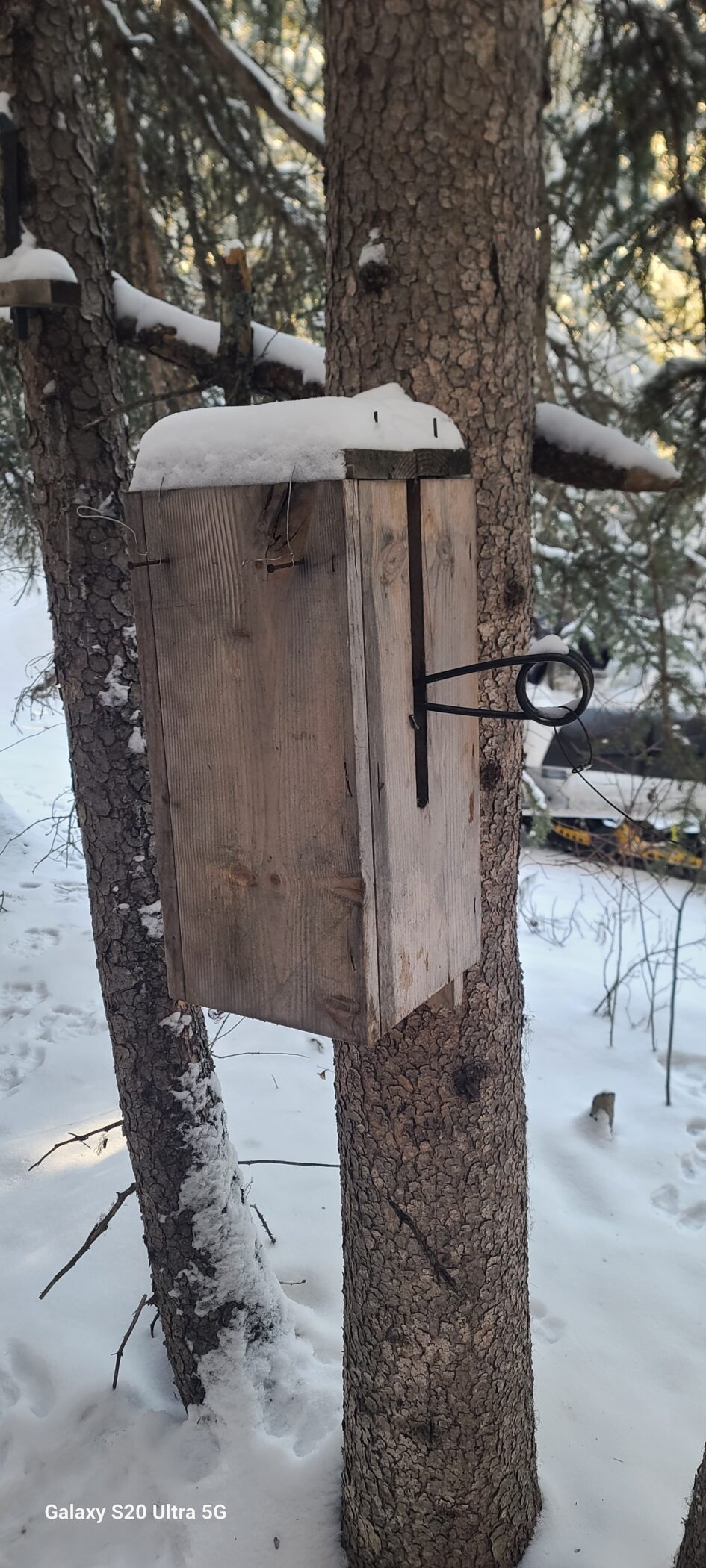
Leave a Reply